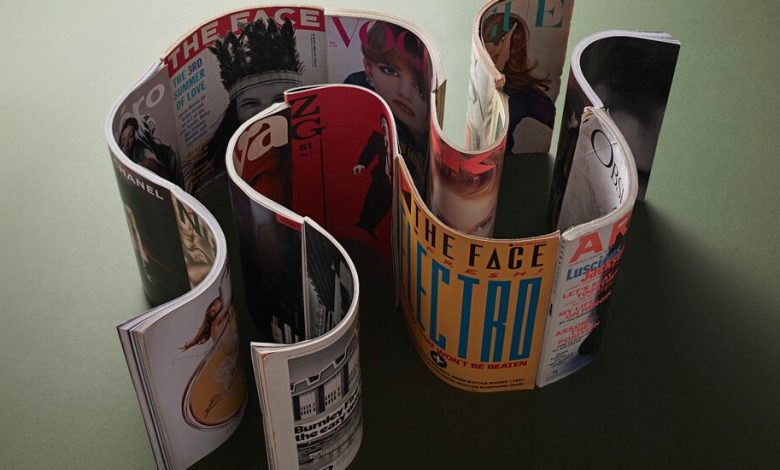To Truly Understand the Past, Pick Up an Old Magazine

How alien are the ways we once described the world; how swiftly we freeze the past into its mere idea, a cartoon of this or that distant year or decade. I’m writing a book about the singer Kate Bush, and another about my education, projects that require much paging through magazines from the 1980s. In the London-based style monthly The Face, I find a cover story on “Electro: the beat that won’t be beaten.” It’s May 1984, the first wave of hip-hop is long past and this summer belongs to the Roland drum machine and the imported sounds of New York clubs. I turned 15 that month, and remember this musical cusp very well. What surprises me now in the pages of The Face: There are just the tiniest hints of the British miners’ strike and the swelling unemployment that are convulsing the country politically. And not a single mention yet of AIDS; in a Wrangler ad, a model’s speech bubble announces, oblivious: “I’m Positive.” In these magazine pages, it both is and is not the 1984 of my memory.
“Priceless flotsam they seemed to us then,” Elizabeth Hardwick once wrote, recalling her youthful fascination with old jazz records. I’ve long felt the same way about magazines, old and new. As a teenager in Dublin in the 1980s, I relied on (mostly British) magazines to keep me informed, and furnish my dreams, about music, fashion, art, literature — and the ways you could write about them. Others my age may know by heart the songs they listened to and poems they read in adolescence, but I remember page layouts: where certain phrases sat in some urgent-seeming essay or review, the choreography of image and caption and byline. My romance with the magazine page thrills away still inside me, so that when research takes me offline to libraries and archives, or (better) into the depths of a dusty eBay find, I can’t stop at the magazine or journal pages I was looking for; I want to read everything, from masthead to classifieds.
Old magazines are cheap time machines, archaeologies of collective desire. Find a print issue, specialist or popular, preferably more than 20 years old (though 10 may do the trick), and read it from cover to cover. You will execute no deep dive, vanish down no rabbit hole; your reading is instead a lateral slice through a culture, class or milieu. A few years ago, while writing a book about great sentences, I went looking for photo captions that Joan Didion composed in the 1960s during her time at Vogue. I found these perfectly formed, uncredited fragments, but also Didion writing about a new museum in Mexico City — “One comes away remembering certain small things, haunted by oddities” — and other high-toned pieces: Hardwick reviewing movies, articles on Alberto Giacometti and Günter Grass. There were fashion photographs by Gordon Parks and William Klein. I confirmed what I suspected about the aesthetic sophistication of midcentury American magazines and their readers.
Carry on reading, however, past famous names and images that seem most of their time, and you find the past does not look or sound as you imagined or recalled. In my prized copy of the August 1965 issue of Vogue, with its listings of private schools and secretarial colleges, “the Sixties” are slightly off. Ideas, images and vocabulary seem not quite right. The fashion is not all miniskirts and over-kohled eyes; throughout there is an obsession with newly subtle and pliable knits, a dream of futuristic comfort and mobility. Writers and advertisers are more apt to deploy “Op” (as in “Op Art”) than “Pop” as a trendy label du jour. There are the expected “youthquakers” — among them Joan Rivers, Edie Sedgwick and Frank Stella — but who is the “young chicerino?” The coinage originated in Vogue a year earlier, and its use dwindled after August 1965. Here is the overheated prose that hymns the chicerino: “In her dreams, action begins … just here, on the lens of her imagination, an image is being fleshed … animated.” Who writes like that today about the young?
I had to buy the May 1984 issue of The Face again; all my teenage magazines were long ago lost or thrown away. But here is a surviving mid-1990s issue of Arena, a magazine for men that I bought once so I could read a single piece (a personal essay on addiction by the critic Ian Penman) and have reread at least once a year ever since. A different sort of realization occurred: It seems I’m allergic still to the “men’s magazine” as such, and in particular to the trends and tastes of that time, with their pervasive legacies. Penman aside, the issue is a horror show of Hummers, horrible tech and bad takes on modern dating, the nadir of British “lad” culture. Yet it’s fascinating, down to the briefest smirking “girlCAM” report; these antiquities inhabit a primitive dream of our present.
Of course, you might come away from such pages smirking at the fashions, assumptions and ambitions of the past — or with a nostalgic ache for its objects, textures or habits of speech. But also a sense that the past is never the past of present cliché, any more than our present is purely itself, entirely made of the self-celebrating now. I have recommended close attention, cover to cover; but you could also give in, across bristling magazine layouts, to pure distraction, which our century did not invent.
Brian Dillon is the author, most recently, of “Affinities: On Art and Fascination.”




